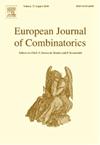Building graphs with high minimum degree on a budget
IF 0.9
3区 数学
Q1 MATHEMATICS
引用次数: 0
Abstract
We consider the problem of constructing a graph of minimum degree in the following controlled random graph process, introduced recently by Frieze, Krivelevich and Michaeli. Suppose the edges of the complete graph on vertices are permuted uniformly at random. A player, Builder, sees the edges one by one, and must decide irrevocably upon seeing each edge whether to add it to her graph (of already selected edges) or not. Suppose Builder decides to add an edge to her graph if and only if at least one endpoint has degree less than in her graph. Frieze, Krivelevich and Michaeli observed that this strategy succeeds in building a graph of minimum degree at least by , the hitting time for having minimum degree . They conjectured that any strategy using fewer edges, where is any constant, fails with high probability. In this paper we disprove their conjecture. We show that for Builder has a strategy which purchases fewer edges and succeeds with high probability in building a graph of minimum degree at least by . For we show that any strategy using fewer edges fails with probability bounded away from 0, and exhibit such a strategy that succeeds with probability bounded away from 0.
在预算上建立具有高最小度的图形
我们考虑在Frieze, Krivelevich和Michaeli最近引入的控制随机图过程中构造最小度k≥1的图的问题。假设n个顶点上的完全图的边均匀随机排列。玩家,建造者,一条一条地看到边,并且必须在看到每条边后不可撤销地决定是否将其添加到她的图中(已经选择的边)。假设Builder决定在图中添加一条边,当且仅当图中至少有一个端点的度小于k。Frieze, Krivelevich和Michaeli观察到,该策略成功地构建了一个最小度至少为k × τk的图,τk是最小度为k的命中时间。他们推测,任何使用较少的n条边的策略,其中,π >;0是任意常数,都有很高的失败概率。本文反驳了他们的猜想。我们证明,当k≥2时,Builder有一个策略,它购买的边数量减少n/9条,并且高概率地成功构建了一个最小度至少为k × τk的图。当k=1时,我们证明了任何使用较少的n条边的策略都以离0有界的概率失败,并展示了这样的策略以离0有界的概率成功。
本文章由计算机程序翻译,如有差异,请以英文原文为准。
求助全文
约1分钟内获得全文
求助全文
来源期刊
CiteScore
2.10
自引率
10.00%
发文量
124
审稿时长
4-8 weeks
期刊介绍:
The European Journal of Combinatorics is a high standard, international, bimonthly journal of pure mathematics, specializing in theories arising from combinatorial problems. The journal is primarily open to papers dealing with mathematical structures within combinatorics and/or establishing direct links between combinatorics and other branches of mathematics and the theories of computing. The journal includes full-length research papers on important topics.

 求助内容:
求助内容: 应助结果提醒方式:
应助结果提醒方式:


